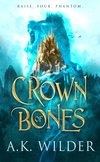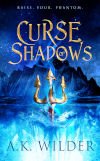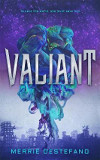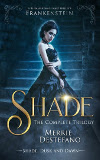.
#YoW Year of Worldbuilding
#WiF Worldbuilding in Fantasy
Last month, I
heralded 2020 as the year I intended focusing on Worldbuilding in Fantasy fiction, emulating 1919 as the Year of Romance: #YoR; #RIFF
 |
Worldbuilding lies at the heart of Fantasy fiction
Art (c) PJ Fitzpatrick |
I indicated, too, that I intended following last year's formula in terms of the focus
being on some of my personal favorites over the years. I'll also strive to achieve some historical perspective by switching between
older and newer works (as I did with romance.) If possible, I'll keep the
range of fantasy encompassed broad, rather than just sticking to the one
subgenre, such as paranormal urban or epic fantasy.
.
Starting At My Beginning...
Yes, I
am starting with CS Lewis and
The Lion, the Witch & the Wardrobe, in part because of the historical perspective, being first published in 1950.
In doing so, I acknowledge that there are even older contenders from children's literature, such as
The Princess and the Goblin by George MacDonald (1872) or
Five Children and It by E Nesbit (1902.) A focus on adult literature might also bring me to
The Worm Ourubous by ER Eddison (1922) or
The King of Elfland's Daughter by Lord Dunsany (1924).
All have their claims to fantasy and worldbuilding renown – but here's the thing: long before any of these titles crossed my ken, and certainly well before I discovered such worldbuilding heavyweights as JRR Tolkien's
The Lord of the Rings (1954) or Frank Herbert's
Dune (SF; 1965), my eight-year-old brother loaned his seven-year-old sister a library book with the brotherly advice to:
"Don't mind the cover, I think you'll like the story."
I
didn't like the cover, because the book was old and not at all colorful: it was gray, with a couple of kids, a lion, and two strange animals on the front, mostly detailed in black. It looked kind of dull, in fact, but eventually, still grudgingly I got myself past the cover and opened the book – and in very short order was surprised by delight.
And that dear Supernatural Undergrounders, is the main reason why
The Lion, the Witch & the Wardrobe is my first contender for the Year of Worldbuilding. I still believe that its opening worldbuilding, which sets up both the book and the subsequent series in a few short scenes, is among the most masterly –
and influential – in Fantasy literature.
It certainly drew me in, much as Lucy is drawn through the wardrobe and into Narnia. In my case, not just into the particular story, but to become an explorer of Fantasy (and other Speculative Fiction Fiction) worlds for life.
.
Surprised By Delight

So what wrought that first delight? At the macro level I believe it's the sheer magic of Lucy first finding herself in the wardrobe, then the gradual sensory revelation that it's more than what it seems. As readers, we experience the wardrobe's darkness with Lucy, moving through the softness of fur coats with the expectation of touching timber.
Instead, Lucy experiences a crunch underfoot, with the revelation of the unexpected, something
"soft and powdery and extremely cold" set up through contrast with her expectation of the
"hard smooth wood of the floor." Within a few moments, she finds herself among trees (again, more tactile contrast with the previous furs) with snow "falling on her":
"A moment later she found that she was standing in the middle of a wood at night-time with snow under her feet and snow flakes falling through the air."
Like Lucy, I-as-reader felt
"a little frightened, but...very inquisitive and excited as well." After all this transition, so expertly managed through a grounding in changing physical sensation and reality, felt both very real and quite unexpected, not to mention mysterious. At the same time, Lucy also notices
"...a light ahead of her."
Consequently, "
she began to walk forward, crunch-crunch
over the snow and through the wood toward the...light."
At which point Lucy, and the reader, reach one of the most famous, atmospheric, and puzzling (it's the working-things-out, via Lucy, that really snares the reader's attention, I believe) worldbuilding scenes in Children's and Fantasy literature.
"In about ten minutes she reached it [the light] and found it was a lamp-post. As she stood looking at it, and wondering why there was a lamp-post in the middle of a wood and wondering what to do next, she hard a pitter-patter of feet coming towards her. And soon after that a very strange person stepped out from among the trees into the light of the lamp-post. ...[A description of the person follows, including that he was carrying an umbrella and parcels, concluding with:]... "...he was a Faun.* And when he saw Lucy he gave such a start of surprise that he dropped all his parcels.//"Goodness gracious me!" exclaimed the Faun."
*Given my age, I recall spending some time puzzling over "Faun" as opposed to "fawn." ;-)
The reasons this scene is so significant in worldbuilding terms (imho) is because of what it establishes in so short a time: just four to five pages from Lucy first entering the wardrobe to encountering Mr Tumnus, a citizen of that world. Those few pages establish the winter world of Narnia that is pivotal to the story told in
The Lion, the Witch & the Wardrobe.
The lamppost and the meeting with Mr Tumnus also establish Narnia as a magical realm of mysterious artefacts and denizens, beginning with the Faun but including animals that talk. This early scene also establishes the pivotal role Lucy and other children will play in the Narnia.
Yet all of this is done with the minimum of props: just the building wonder of Lucy's transition through the wardrobe, the added curiosity of the lamppost shining in the middle of the forest, and finally the crowning arrival of the faun with his parcels, his woolly scarf and his umbrella. Altogether, it's a sequence of pages that surprises with delight, sets up the existence of magic and wonder, and establishes a world in which the reader, through Lucy, believes in all of it.
Lewis does not rest on his worldbuilding laurels, though. Within a few short pages of Lucy's return, but slightly longer in the timeframe of the story, her brother Edmund also ventures the wardrobe. In many ways his entry into Narnia mirrors Lucy's: the transition through the wardrobe, the discovery of the winter world – only in his case he does not meet the faun but a beautiful and rather terrifying Queen.
The duplication cements the basis of the world; the encounter with the Queen reveals the darker and more deadly aspect of the winter and the magic that holds Narnia in its grip. At the same time, it establishes the conflict that must be resolved in the story through the conflicting experiences of Lucy and Edmund.
This conflict is then set in motion with the third transition through the wardrobe by all four children: Lucy, Edmund, and their elder siblings, Peter and Susan. As it should be – three times counting for all, after all, in the best fairytale tradition. :-)
And it is in this third transition that the children meet the first of Narnia's talking animals, Mr and Mrs Beaver, thereby confirming the final, but arguably the most important element of the Narnia world.
These elements – the wonder and delight of lampposts, magical creatures and talking beasts, and the darker and more terrible side of magic embodied in the witch-queen and the winter – are themes that will play out time and again. Not just in
The Lion, the Witch & the Wardrobe (when the children must find the lion, Aslan, and defeat both witch and winter) but throughout the series of seven books.
For these reasons, I believe CS Lewis's worldbuilding in
The Lion, the Witch & the Wardrobe is an
outstanding example of the genre.
It is also one (possibly of the few) that is well known beyond the fantasy genre.
 |
| Finding Narnia... |
One example of its reach stems from a decade or so ago, when the Large Hadron Collider (LHC) was about to go live. At the time, there was considerable fear in some quarters that it might generate a black hole, thereby destroying the planet. I remember hearing a radio interview at the time, when a LHC physicist indicated that
there was far more chance of someone entering a wardrobe and finding Narnia, than there was of the LHC creating a black hole.
I recall laughing out loud, both at the humor, but also at the power of fantasy worldbuilding made manifest in our "real" and "everyday" world. I could say "muggle" world at this point, but won't, because that would be getting ahead of myself...
On that note: see you next month for my next instalment of the Year of Worldbuilding in Fantasy!
---
Note: On February 16 Kim Falconer will be doing a post on Fantasy realms that appear on the real-world map – a nice segue on the worldbuilding theme, so check back in for that. :-)
---
Helen Lowe is a teller of tales and purveyor of story, chiefly by way of novels and poetry. Her first novel, Thornspell (Knopf), was published to critical praise in 2008. The second,The Heir of Night (The Wall Of Night Series, Book One) won the Gemmell Morningstar Award 2012, and the sequel, The Gathering Of The Lost, was shortlisted for the Gemmell Legend Award in 2013. Daughter Of Blood
(Book Three), was published in 2016 and Helen is currently completing
the final novel in the series. She posts regularly on her “…on Anything, Really” blog, monthly on the Supernatural Underground, and is also on Twitter: @helenl0we.



































